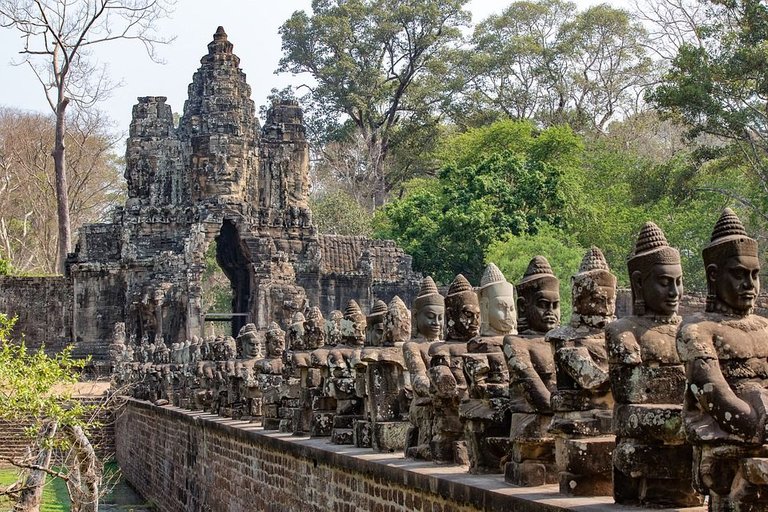
Constructed towards the end of the 12th century by the Khmer people (under the rule of King Jayavarman VII), Angkor Thom is a sprawling walled city made from a red clay material known as laterite. It spans an area of 9 square kilometres, featuring giant monuments and intricate artwork from previous eras. The city has face-towers at each entrance and all towers are decked with gigantic figures. At the heart of the city is the Bayon, the king's state temple. The city's other main attractions can be found on the north, surrounding the Victory Square.
The city rests on the west side of the Siem Reap River. 7.2 kilometres below the south gate is the city of Siem Reap. The southern end of Angkor Thom is just 1.7 kilometres away from the famous Angkor Wat. The city's 8-meter walls are surrounded by a 3-kilometer moat, covering an area as large as the city itself. All the gates, located on the city's major points, open to roads that lead straight to the state temple. To the east is Victory Square, while the Royal Palace is situated to the north of the Bayon.
History
Angkor Thom means great city. It was a fitting name for the new capital of the Khmer Kingdom, which King Jayavarman VII constructed after he successfully drove out the Chams – the people responsible for the destruction of Khmer's former capital, Yasodharapura. To ward off threats to the kingdom's peace, the king had the city surrounded by high walls, complete with a wide moat enclosure. Even after the new kingdom was built, a number of older monuments that were already in place were retained. These monuments include the Phimeanakas, a 10th century Khleang-style Hindu temple, and the Baphuon, an 11th century three-tiered former state temple dedicated to the Hindu goddess Shiva.
King Jayavarman VII's Royal Palace, built to the north of the Bayon, did not withstand the test of time. Since the palace was made from light materials, only the stone terraces – the Elephant terrance and the Leper King terrace – can be seen at present. There were thousands upon thousands of commoners who inhabited the city and once resided in wooden houses, which have long since decayed. Angkor Thom was praised for being advanced beyond its years and the kingdom provided for its citizens' basic needs. In addition to well-developed roads and waterways, the city had four hospitals and places where cityfolks could engage in trade and commerce.
In the 1800s, the Khmer Kingdom started to lose its influence and the city became deserted. French explorers rediscovered the city covered in thick wild jungle plants. An organization called the Ecole Francaise d'Extreme-Orient commissioned a team to clear and restore the monuments to its former glory. Today, Angkor Thom is one of the top tourist attractions in Cambodia, along with Angkor Wat. Millions of tourists visit the country each year just to see the temples and the walled city.
How to Get to Angkor Thom from the Airport
The Siem Reap International Airport (SRIA) is just a few minutes away from Angkor Wat, the entrance of which is just less than 2 kilometers away from the southern gate of Angkor Thom. Prior research is a plus so you are fully aware of where you intend to go and how much prices are pegged for various necessities including transportation, food, accommodation and souvenirs among others. SRIA is considered one of the world's busiest airports. Tourist flock the airport because of its proximity to the Angkor Complex. The following airlines have flights available in SRIA:
- Air Asia
- Air Busan
- Air Seoul
- Bangkok Airways
- Bassaka Air
- Beijing Capital
- Cambodia Angkor Air
- Cambodia Bayon Airlines
- Cathay Dragon
- Cebu Pacific
- China Eastern
- China Southern
- Eastar Jet
- HK Express
- Hainan
- Jetstar Asia
- Korean Air
- Lao Airlines
- Lucky Air
- Malaysian Airlines
- Shandong
- Silk Air
- Sky Angkor
- Spring Airlines
- Thai Airways
- T'way
- Vietnam Airlines
- Xiamen Air
Be reminded of the following when you arrive in the area:
- From the Siem Reap Airport, you have the option to ride a taxi straight to Angkor Wat or Angkor Thom. Most tourists stop by Angkor Wat first before taking a side trip to the old Khmer capital. Ideally and in the event the driver charges you with the regular meter rate, a taxi ride from the airport to the Angkor Wat area would cost tourists between 2 and 5 USD. If you are going straight to Angkor Thom, give or take take a few dollars more. Negotiation skills are a plus so drivers can take you there without extra charges.
- Some tourists prefer to go on foot or ride a tuk tuk, following the length of the Airport Road, where most of the hotels, hostels, guesthouses and dining and entertainment places can be found. The Airport Road is also near the town center, where you can do some shopping and buy souvenirs.
- Some tuk tuks do not charge much. A market ride may only cost you a dollar or two. If you intend to explore the expansive Angkor complex, riding a tuk tuk for the rest of the day can save you a lot of needed energy.